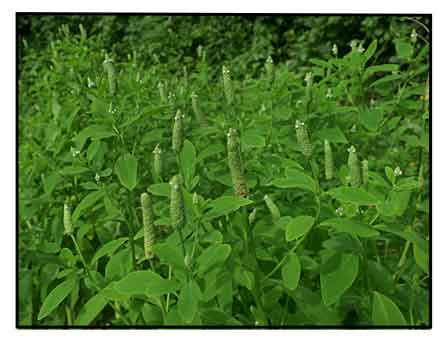 Gen info Gen info
- Sphenoclea is a genus of succulent erect annual herbs with two species: S. zeylanicum and S. pongatium.
- The genus is placed alone in family Sphenoleaceae, a somewhat uncertain position. (14)
Botany
Sphenoclea zeylanicum is an erect, branched herb, up to 150 cm tall. Leaves are simple, spirally arranged, light green; blades oblong to lance-shaped, narrowed at the tip, 10 cm long, borne on short stalks. Inflorescences are green, cylindrical, 7.5 cm long with a dense terminal spike; flowers densely crowded, white to greenish, sessile. Fruit is a flat, 4-5 mm diameter globular capsule. Seeds are yellow brown, 0.5 mm long. (3)
Sphenoclea zeylanicum is a branched annual herb, up to 1.5 m tall. Stems hollow. Leaves lanceolate, narrowly ovate to elliptic, up to 12 × 5 cm, hairless; margin entire; petiole up to 1.5 cm long. Flowers in conical-cylindric spikes, up to 12 cm long. Corolla very small, white, greenish or pink yellow. Fruit a capsule, 4-5 mm in diameter, dehiscing below the calyx lobes, leaving the base attached to the rhachis. (Flora of Zimbabwe) (4)
Distribution
- Native to the Philippines.
- Also native to Afghanistan, Andaman Is., Assam, Bangladesh, Benin, Botswana, Burkina, Burundi, Cambodia, Cameroon,
Central Africa, Chad, China, Congo, Egypt, Ethiopia, Gabon, Gambia, Ghana, Hainan, India, Iran, Iraq, Ivory Coast, Jawa, Lesser Sunda Is, Malawi, Malaya, Mali, Mauritania, Mozambique, Myanmar, Namibia, Nepal, Niger, Nigeria, Northern Territory, Pakistan, Rwanda, Senegal, Sierra Leone, Solomon Is., Somalia. Sri Lanka, Sudan, Sulawesi, Swaziland Tadzhikistan, Taiwan. Tanzania, Thailand, Togo, Uganda, Uzbekistan, Vietnam, Zambia, Zaire, Ziimbabwe. (1)
- Listed as one of the worst weeds in the world.
- A common weed in rice paddies, where it can cause yield losses from 25-50%.
(1)
 Constituents Constituents
- Study for secondary metabolites have yielded alkaloids, tannins, flavonoids, phenols, steroids, phlobatannins, saponins, and cardiac glycosides.
- Study of leaf, stem, and flower extracts in four different solvents yielded significant phytochemicals such as flavonoids, alkaloids, steroids, etc. Quantitatively, phenols were the most abundant phytochemical in the methanol extract.
(5)
- In a study for nutritive and neutraceutical value of leaves, Sphenoclea zeylanica showed major nutritional components (% of dry weight) with moisture content of 93.25, crude protein 23.73, total carbohydrate
7.90, lipid 2,59, crude fiber 13.73, ash content 16.91, and calorific value (Kcal/100g) of 149.83. (9)
-
For free amino acid, dietary antioxidants and in vitro antioxidant activity, S. zeylanica yielded 10.25 mg/g amino acid, phenolics 4.37 mgGAE/g, flavonoids 3.17 mgRE/g, DPPH-RSA 72.06%, DPPH-IC50 2.88 mg/ml. (9)
- Beta carotene extremely high in edible parts; high ascorbic acid; low calcium; low iron, low protein. Edible portions contain some phytic acid.
(13)
 Properties Properties
Studies have suggest antioxidant, antimicrobial, phytoremediative properties.
Parts used
Leaves, whole plant.
Uses
Edibility
- Young leaves and tips of older leaves are edible; usually eaten after slight boiling or steaming, or mixed with grated coconut.
- In India, consumed by the Bodo people in Assam as vegetable.
(6)
- In Bali, Indonesia, cultivated as a vegetable crop by local farmers..
Folkloric
- No reported folkloric medicinal use in the Philippines.
- In Thailand, the herbal weed is used for skin disorders.
- In India, used for treatment of ulcers. (11) Tribes of Tripura, northeast India, used decoction of whole fresh plant for bloody dysentery. (12)
Studies
• Antibacterial: Study evaluated the amino acid profiles, antimicrobial property, and anti-nutritional contents of two wild edible plants, Sphenoclea zeylanica and Sphaerantus peguensis. S. zeylanica yielded higher total amino acid content of 42.87 mg/g dry weight. The methanol extract extract showed antibacterial activity against Bacillus cereus, Staphylococcus aureus, Proteus vulgaris, and Escherichia coli. S. zeylanica showed higher levels of anti-nutritional contents compared to S. peguensis. (6)
• Antimicrobial / Leaves: Study evaluated the antimicrobial activity of leaves, flowers, and stem extracts of S. zeylanica using zone of inhibition method against B. subtilis, P. vulgaris, S. aureus, C. coli, C. albicans, A. niger, S. typhi, and B. cereus. The leaf extract showed notable inhibition of microbial growth against tested organisms, which was attributed to various secondary metabolites. (7)
• Effect of Ethanol Concentration on Antioxidant Activity / Leaves: Study evaluated the effect of concentration of ethanol solvent on antioxidant activity of gonda leaf extract using ultrasonication method. Results showed ethanol concentration had a significant effect on yield, total phenol, total flavonoids, total tannins, and antioxidant activity. A 70% ethanol concentration was best treatment with highest antioxidant activity of 75.75% with IC50 of 123.38 mg/L, 22.86% yield, total phenol extract 40.94 mg GAE/g, total flavonoids 23.48 mg QE/g, total tannins 82.10 mg TAE/g. (8)
• Phytoremediation / Cadmium / Leaves: Study evaluated the efficacy of three weed species (Ipomoea aquatica, Sphenoclea zeylanica, Pistia stratiotes) associated with low-land rice to extract Cd from rice paddy soil near two industrial establishments in rural Philippines. Results showed the weeds can be used for phytoremediation of Cd-contaminated soil. (10)
Availability
Wild-crafted. |

![]()



 Gen info
Gen info Constituents
Constituents Properties
Properties